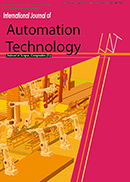Volume 16, Issue 5
Displaying 1-17 of 17 articles from this issue
- |<
- <
- 1
- >
- >|
Special Issue on Recent Progress in Manufacturing Technology
-
Article type: Editorial
2022 Volume 16 Issue 5 Pages 519
Published: September 05, 2022
Released on J-STAGE: September 05, 2022
Download PDF (36K) -
Article type: Paper
2022 Volume 16 Issue 5 Pages 520-527
Published: September 05, 2022
Released on J-STAGE: September 05, 2022
Download PDF (1307K) -
Article type: Paper
2022 Volume 16 Issue 5 Pages 528-535
Published: September 05, 2022
Released on J-STAGE: September 05, 2022
Download PDF (944K) -
Article type: Paper
2022 Volume 16 Issue 5 Pages 536-542
Published: September 05, 2022
Released on J-STAGE: September 05, 2022
Download PDF (487K) -
Article type: Paper
2022 Volume 16 Issue 5 Pages 543-551
Published: September 05, 2022
Released on J-STAGE: September 05, 2022
Download PDF (760K) -
Article type: Paper
2022 Volume 16 Issue 5 Pages 552-561
Published: September 05, 2022
Released on J-STAGE: September 05, 2022
Download PDF (552K) -
Article type: Paper
2022 Volume 16 Issue 5 Pages 562-571
Published: September 05, 2022
Released on J-STAGE: September 05, 2022
Download PDF (970K) -
Article type: Paper
2022 Volume 16 Issue 5 Pages 572-581
Published: September 05, 2022
Released on J-STAGE: September 05, 2022
Download PDF (719K) -
Article type: Paper
2022 Volume 16 Issue 5 Pages 582-587
Published: September 05, 2022
Released on J-STAGE: September 05, 2022
Download PDF (357K) -
Article type: Paper
2022 Volume 16 Issue 5 Pages 588-597
Published: September 05, 2022
Released on J-STAGE: September 05, 2022
Download PDF (667K) -
Article type: Paper
2022 Volume 16 Issue 5 Pages 598-608
Published: September 05, 2022
Released on J-STAGE: September 05, 2022
Download PDF (2079K) -
Article type: Paper
2022 Volume 16 Issue 5 Pages 609-614
Published: September 05, 2022
Released on J-STAGE: September 05, 2022
Download PDF (460K) -
Article type: Paper
2022 Volume 16 Issue 5 Pages 615-623
Published: September 05, 2022
Released on J-STAGE: September 05, 2022
Download PDF (1112K)
Regular Papers
-
Article type: Paper
2022 Volume 16 Issue 5 Pages 625-633
Published: September 05, 2022
Released on J-STAGE: September 05, 2022
Download PDF (1418K) -
Article type: Technical Paper
2022 Volume 16 Issue 5 Pages 634-641
Published: September 05, 2022
Released on J-STAGE: September 05, 2022
Download PDF (349K) -
Article type: Paper
2022 Volume 16 Issue 5 Pages 642-653
Published: September 05, 2022
Released on J-STAGE: September 05, 2022
Download PDF (764K) -
Article type: Paper
2022 Volume 16 Issue 5 Pages 654-665
Published: September 05, 2022
Released on J-STAGE: September 05, 2022
Download PDF (967K)
- |<
- <
- 1
- >
- >|
